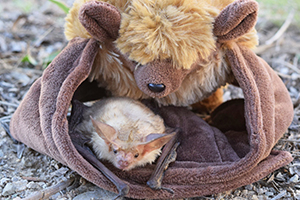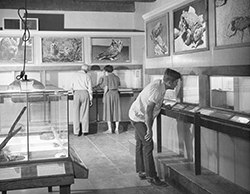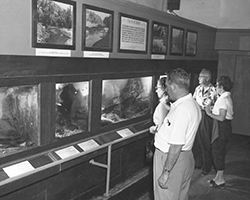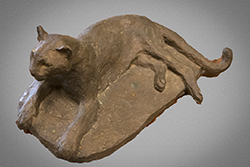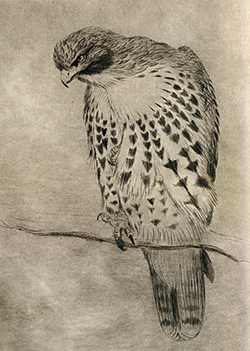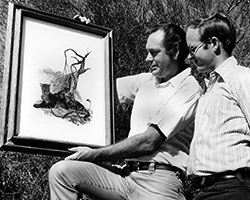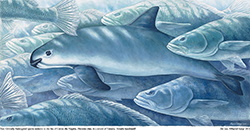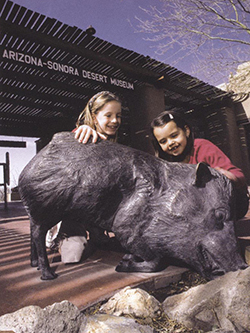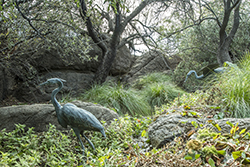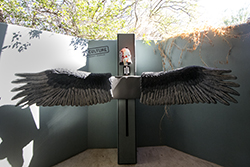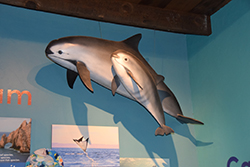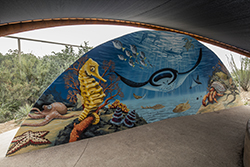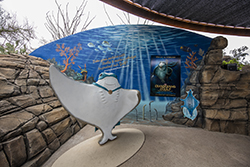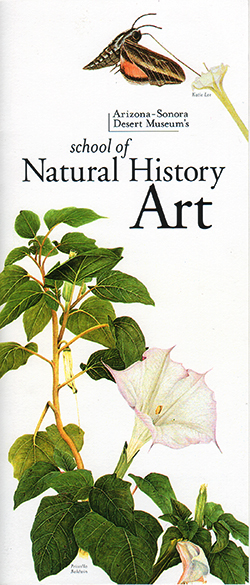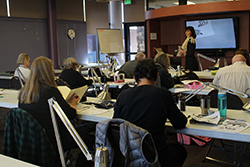
Art and Exhibitry — the ASDM Tradition Continues
'I’d like to see a natural history art museum as part of the Museum’s complex' — William "Bill" Carr, 1976. Those words from the Arizona Sonora Desert Museum 's (ASDM) co-founder forged links between art and the ASDM.1
Art has long been a part of the Desert Museum's legacy whether it's the dioramas that grace the Amphibian Room — or the baby javelinas by Mark Rossi on the patio that charm visiting children as they wait to enter the museum — or the iconic George L. Mountainlion image by Nick Wilson that continues to capture the enduring spirit of the museum.
According to Merv Larson, former ASDM Executive Director, 'We needed a way to show visitors how animals lived, what their habitats were like - so we began designing, building and painting ‘living’ dioramas that featured the natural terrain of the animals and reptiles of the Sonoran desert. Part of this idea came from my early work with the California Academy of Sciences in San Francisco where they featured these huge murals and dioramas. So we came up with the idea of adapting the dioramas — whether it be the desert, the mountains or the ocean — to the smaller scale of our "new" museum here in southern Arizona. We started in the Amphibian Room where we featured frogs, toads, and salamanders. We then moved on to the Small Animal Room where we incorporated simulated soil and rock foregrounds with background paintings in small colorful dioramas to illustrate the lives of our new "residents - chuckwallas, kangaroo rats and pack rats" '.
'Once we realized the value that design and art added to the exhibits, it was only natural that we started keeping an eye out for talented individuals who could help us with design and fabrication. That's the way that Nick Wilson came to work here. We saw work that Nick did for Nevada Fish and Game out of Reno. We contacted Nick, invited him down for an interview and hired him immediately on the basis of his very realistic work. We have Nick to thank for many of the graphic images the Desert Museum uses today including George L.
Dion Wright's work came to our attention in a different, but equally serendipitous way. Dion was visiting the museum on a spur of the moment road trip with a friend and had a five-foot high praying mantis sculpture with him which he left with staff at the front entry while he toured the museum. I saw it, liked it, bought it for the museum, and offered him a job. Dion went on to produce the 'Evolution of Birds ' sculpture that graces the wall of the Aviary.
Robert 'Bob' Sewell came to us via Disney. With his eye for art and his experience painting habitat dioramas for the American Museum of Natural History, Sewell was a natural fit to help create dioramas for the Desert Museum. The diorama in the Sonoran Desert Toad exhibit is still in use today in the Reptile and Invertebrates Room.’
A large number of designers and artists have contributed to the exhibits and art collections of ASDM. Here's a sampling of past and current ASDM artists:
- Sheridan Oman
-
Sheridan Oman was an enigma as a person, but such a talented artist!
Sheridan Oman came to the Desert Museum originally as an animal keeper working with birds. He later went on to design and paint a wide variety of dioramas, and to create a stunning set of images in a variety of media including sculpture, pen and ink, and mixed media. ‘(Sheridan) Oman’s obsession and passion was nature,‘ which he demonstrated through his work at the Desert Museum and later through his own highly independent and very much treasured work.2
'I believe the museum's visual arts program, where we blend art and science, creates some of the most compelling experiences that inform the viewer as well as lead them to form emotional connections to this precious environment. Perhaps nowhere is this more apparent than with Sheridan Oman, whose medium was art, but whose language was nature. He demonstrated not only a deep understanding of the natural world, but also a longing to present this to others so they could come to know it as he had,' Craig Ivanyi, current ASDM Executive Director.4
- Nick Wilson
-
'(Art) has a very important part (to play in natural history museums). — I like the marrying of the two concepts of art and natural history. — I think it all adds to the special place you are when you're among these live animals, as well as the artistic aesthetics of wildlife that inspire artists to create them. — I say the live animals inspire artists to create them and the art they create creates a greater interest in the live animal.'
Nick was responsible for the first artist poster collection at the museum. He is well-known for his representations of rabbits and mountain lions including the iconic George L Mountainlion 'head'. 'I've always pictured a mountain lion larger than life at the entrance to the (Desert) Museum.' Nick also has taught at the Art Institute with an emphasis on sculpture.
- Rachel Taylor Ivanyi
-
Rachel Ivanyi is a freelance, natural science illustrator, who works on a variety of natural history subjects. She combines a love of nature and science with the power of observation.
‘Little did I know when I arrived in Tucson in the mid-1990’s as a graduate student with the University of California at Santa Cruz, and joined the Desert Museum as an intern in the Design & Planning Department (Exhibits & Graphics, now), that over twenty years later I would be living in Tucson and still be creating art for the Museum, as well as teaching art classes for the ASDM Art Institute.
I care deeply about the natural world and am very passionate about the conservation mission of the Desert Museum. That is why it means so much to me that I have been fortunate enough to contribute to honoring its history, as well as helping it stay current and explore new ways of interpreting the Sonoran Desert through art exhibition and education.’
- Mark Rossi
-
'I get an idealistic feeling that the Desert Museum belongs to all of us and is an informational oasis in the Sonoran Desert. Its existence offers so much to me, and I'm really happy to attempt a mutual kind of relationship with the DM.' Rossi is responsible for the group of javelinas at the Desert Museum entrance and a dozen lizards around the enclosed reptile exhibit, as well as several other pieces on museum grounds.
- Michael Lee
-
Michael first worked on exhibits for ASDM in 1990. He served as a full-time Desert Museum employee from 2001 to 2007, working primarily on Life on the Rocks. Michael Lee is now an independent artist and designer focusing on sculpture and exhibitry, particularly using molds and casts. He was part of the design team that created the Association of Zoos and Aquariums-recognized Vulture Culture exhibit that opened in 2015. He also created the vaquita models that float over the Warden Aquarium.
‘I like art that surprises people and makes them remember new experiences. Going around a corner and being surprised and delighted by an art piece…that’s a memory that will be treasured. I’ve done a variety of things, but the Museum is kind of my home away from home.’
And there’s more —
The Desert Museum continues its light-hearted, but yet serious message of the importance of conservation of our Sonoran coastal waters through its design work at the Sting Ray exhibit, which opened in August, 2016.
Moving Forward —
The intertwining of art and the museum continues. In 2001, the Desert Museum launched the Arizona-Sonora Desert Museum Art Institute (School of Natural History Art), established to foster conservation through the arts. The Art Institute follows the leadership of the Priscilla and Michael C. Baldwin Foundation, in working to inspire 'Conservation through Art Education'. Today, the Art Institute offers a wide variety of programs, including adult art and photography classes, workshops, and a nature illustration certificate program. Art Institute classes are complemented by exhibitions in the Ironwood Gallery and the Baldwin Education Building. In addition, the museum's internationally recognized Vanishing Circles exhibit recently traveled to Universum, the Science Museum of the National Autonomous University of Mexico where it was very well received. This exhibit marked the first ASDM collaboration with an organization in Mexico City. Detailed class information and schedules can be found on the Art Institute web site.
As Peggy Larson, Desert Museum librarian and archivist reflected, 'We've long exhibited plants and animals in excellent, naturalistic exhibits, written about them, talked about them, filmed them and demonstrated their behavior and biology. Through the fine art works collected and/or exhibited at the Museum and through the Art Institute classes, the Museum staff, students and visiting instructors provide a valuable perspective of the plants, animals and landscape. We see things through the eyes of artists who, through their art, display their personal and emotional insight. Art stretches our minds, our connections, and our empathy for the desert and the living things in it.' 5
‘Art and exhibit design work have long been linked at the Desert Museum. The visual enhances and the tactile teaches — whether you’re an adult or a child there’s always a new way to learn. The next time you’re at the museum, look around you and see how art and exhibitry work closely together to help you learn more about the Sonoran Desert Region and the plants and animals that inhabit this place we call home!’ — Craig Ivanyi
- Interview of William 'Bill' Carr by Margaret Gerow - 7/17/1976 - Source: ASDM Archives
- Herb Stratford, Sheridan Oman - Abbreviated Biography. Reproduced with permission: 'In Search of Sheridan Oman - The Art of a Desert Recluse' - Arizona Sonora Desert Museum Art Institute.
- Courtesy John Leyden collection
- Reproduced with permission: 'In Search of Sheridan Oman - The Art of a Desert Recluse' - Arizona Sonora Desert Museum Art Institute
- ASDM Oral History Interview - 2/7/2012
- Photography courtesy of ASDM Archives, ASDM Art Institute, Marvin Frost, Kenny Don, and Anne C. Warner



